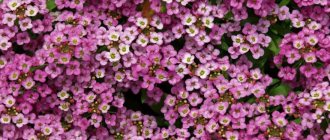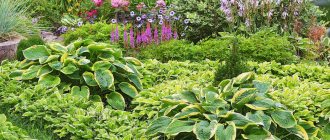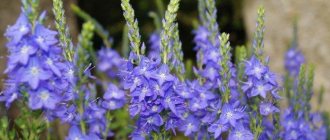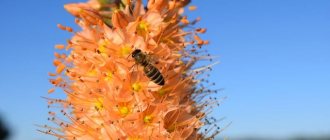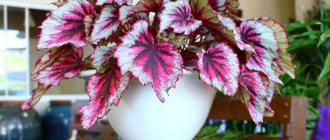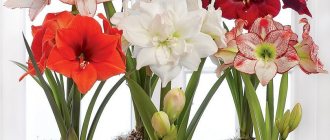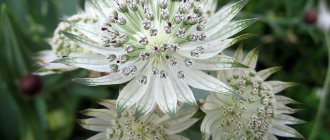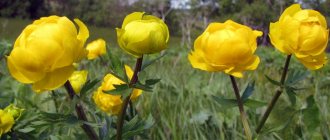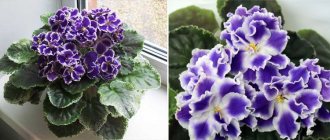Forget-me-not flower - description
What kind of eyes are these? Whose are they? Their owner is well known to us under the name “forget-me-not.” A tiny flower, so modest and indecisive that even at the time when the Lord bestowed names on all his subjects, he stood aside and would have remained nameless if the Lord had not called him and said: “I will never forget you, delicate, modest flower. And people will not forget you once they see you. And your name will be “ forget-me-not”
«.
Today, under the common name “forget-me-not” we know several representatives of the borage family. This is the well-known forget-me-not (Myosotis), and flowers similar to it, but distinguished by the large broad-fingered leaves of Brunnera, as well as their friend from the shady forests of the Western Caucasus - Omphalodes.
Planting brunera in open ground important points
How I grow large-leaved hydrangeas - macrophiles in the Moscow region. Olin's experience
Having decided to decorate your own garden with brunera, you have made the right decision. She is so unpretentious that even an experienced gardener will be amazed. It is enough just to remember that the flower does not tolerate direct sunlight, which causes burns of the leaves and loss of decorativeness. Therefore, the best place is partial shade or shade, the location is closer to the water. In this case, you will not need to water the plant once again, and it will delight you with its amazing foliage color all season long!
But if care does not require much labor, then planting a new bush is the opposite. You should stock up on time and patience - and then your garden will be decorated with more than one brunera bush.
Usually planting a new bush is associated with dividing an old, already overgrown one.
Taking into account that brunera is capable of living in one place for up to 15 years, it can be divided and propagated every 3rd year. To do this you need:
- trim the mother bush to a height of 15-20 cm. The time for dividing the bush and planting is late July-early August;
- dig up the root, rinse well in water;
- divide into parts. Usually the bush disintegrates on its own, if not, you should resort to using a knife;
- dip the roots of each new bush in a preparation that stimulates their growth, plant them in holes at a distance of at least 50-70 cm from each other;
- water.
Differences between forget-me-nots and brunnera and omphalodes
The main biological difference between forget-me-not and brunnera and omphalodes is that forget-me-not is a biennial, using mainly seed propagation, while brunnera and omphalodes are perennials that practically do not set seeds and reproduce by dividing the rhizome.
The flowering of the beautiful forget-me-not begins at the end of April and lasts more than a month until the beginning of June. During July, the seeds ripen and self-sow, which germinate very quickly - so that by mid-August, dozens of tiny young bushes are already showing off next to the mother plant. They will bloom only next spring, when the mother plant has already died, thereby completing the two-year life cycle of each forget-me-not. Garden forget-me-not is much more tender than its forest sister, although in comparison with other garden biennials it can be considered perhaps the most undemanding and unpretentious crop. It will bloom and develop equally well both in the shade and in sunny areas. Even the short-term drying out of the soil in spring, which occurs between the melting of snow and the first thunderstorms in May, is tolerated very easily by forget-me-nots. It is not afraid of short-term frosts on the soil down to -5°C.
6. Application in landscape design
Brunner will become a bright accent on any flower garden or flower bed. Even after flowering, its large, often variegated leaves will decorate the area throughout the summer.
Even when grown in the shade, you can get excellent herbaceous cover, so the flower can be used where many plants simply cannot survive. Low varieties are used as a border plant, serving as an edging for large plants or highlighting a garden path. Brunnera looks great planted near a small pond; in addition, in such conditions the plants feel great.
↑ Up,
Growing forget-me-nots
types of forget-me-nots grown in culture.
(Myosotis) - marsh forget-me-not (Myosotis palustis) and forest forget-me-not (Myosotis sylvatica).
Swamp forget-me-not (Myosotis palustis)
- has the largest bright blue flowers among forget-me-nots, reaching 1.2 cm in diameter, and very strong and shaggy stems up to 40-50 cm long. Its bright green leaves match the overall appearance of the plant and reach 8 cm in length and 2 cm in width. Forget-me-not marsh prefers damp and shady places, so it is most often used to decorate the banks of decorative reservoirs.
Forest forget-me-not (Myosotis sylvatica)
- differs from swamp forget-me-not in darker blue flowers, not exceeding 1 cm in diameter, and very weak and long (up to 40 cm in length) stems and thin branched rhizomes, located under the very surface of the soil and growing slightly obliquely, even sometimes protruding above the level earth. The leaves of the forest forget-me-not are wide, dark green, overwintering, oval in shape and located along the entire length of the stem. Unlike the swamp forget-me-not, the forest forget-me-not is a less moisture-loving plant, so it is successfully used to decorate flower beds next to tulips.
Very similar to its blue-eyed friend, but different from it with large heart-shaped leaves, Brunnera - it came to our region from the damp, shady forests of the Caucasus and Southern Siberia. This is a luxurious perennial, represented in cultivation by two species - large-leaved Brunnera (Brunnera macropylla) and Siberian Brunnera (Brunnera sibirica). It is incredibly resistant to all the vagaries of freezing Russian winters, and does not require any soil preparation for planting or special care. It is enough to plant Brunnera rhizomes once in late July-August in a shaded and moist area of the garden - and next spring its curious blue eyes will greet you, creating an indescribable feeling of a whole sea of heavenly drops that unexpectedly fell on the earth waking up from a long winter sleep. Without replanting, a brunnera bush can exist for more than ten years, gradually growing and turning the area allocated for it into a real blue sea. Even after the end of flowering, which lasts about a month, the large, lush green leaves of Brunnera form a beautiful carpet that suppresses the growth of weeds and turns even the most abandoned and unsightly areas of the garden into cozy flower beds. When grown on waterlogged soils and areas of land exposed to constant winds, as well as in rainy years, Brunnera is damaged by brown spot - a fungal disease carried by the wind and primarily damaging weakened plants growing outside favorable conditions. To combat this disease, all affected above-ground parts of the plant should be removed, and healthy plants should be treated with a fungicide solution. And another representative of the wonderful blue-eyed family is Omphalodes. It is represented in culture by two of the most popular species - Omphalodes cappadocia (Omphalodes cappadocia) and spring Omphalodes (Omphalodes verna). Growing in its natural areas, Omphalodes cappadocia already in April-May covers the harsh rocky gorges of the Western Caucasus with its amazing pale blue flowers. However, in the conditions of Central Russia, the flowering of omphalodes becomes very scarce, seeds practically do not set, and from a perennial plant, omphalodes turns into an annual. Therefore, its cultivation does not cause much enthusiasm among amateur gardeners. However, its “namesake” is Omphalodes verna.
- has gained well-deserved popularity not only among flower growers of the Middle Zone, but also on European lawns and flower beds. Its bright blue flowers, larger than those of the forget-me-not, reaching 0.8-1 cm in diameter, cover flower beds and ceremonial flower beds and even entire terraces with a real carpet thanks to a distinctive feature of Omphalodes - vegetative growth. Omphalodes vernalis is extremely resistant to almost any unfavorable conditions - both cold winters and summer drought. It is not damaged by diseases or pests and the only condition for its successful cultivation is the selection of a well-drained site. And finally, let's talk about one more wonderful feature of all representatives of the blue-eyed family - their excellent resistance to cutting. Once cut and placed in wide pots with cool, clean water, forget-me-nots, brunners, and omphalodes can last for about a month. More and more blossoming flowers will replace their fading counterparts, filling the room with the most delicate radiance and creating the sensation of a huge drop rolling down a fantastic leaf from the azure skies straight to your room. And even despite the bright sun blazing outside the window, your home will always be cool and fresh thanks to these delicate flowers, so pure, naive and infinitely sincere - after all, these are real drops of heaven that fell to the ground.
4.Reproduction
There are 3 ways to propagate a flower - seed or generative, vegetative - by cutting roots or dividing large adult plants. Varietal and variegated bushes should be propagated only vegetatively, since only in this case will they be able to fully retain the declared varietal characteristics of the parent plants.
↑ Up,
4.1.Growing from seeds
Brunnera is often propagated by seeds sown directly in open ground in the autumn months. For planting, it is worth choosing a time so that night frosts do not occur within 2 weeks after sowing. With this method of propagation, the planting material will be subjected to natural stratification. When sowing in spring, a period of cool stratification should be organized artificially. For stratification, planting material is placed in small bags and placed in the vegetable compartment of the refrigerator for 3 - 4 months.
↑ Up,
Seed propagation does not cause difficulties and often when grown in open ground, self-seeding can be found under adult plants. It is worth noting that species brunners will retain their appearance when grown from seeds, but varietal plants can be strikingly different from the parent bushes.
For propagation, you can use planting material collected from flowering plants. Unfortunately, the seeds often do not have time to fully ripen, especially if night frosts occur early in the autumn.
It is advisable to collect seeds in dry, warm and windless weather. After collection, the change is dried for several days in a warm and ventilated room, and then sent for storage, sprinkled with slightly damp river sand and placed in paper bags or fabric bags.
↑ Up,
Seeds are planted in open ground in the fall, before frost. For sowing, prepare a plot of land with shallow furrows. Planting material is planted to a depth of about 5 - 10 cm and watered abundantly. The first leaves will appear in this place in the spring; as they develop, the plants are planted.
Sowing in seedling containers is carried out in late winter - early spring. It is worth making drainage holes at the bottom of the containers and filling them with nutrient substrate. Sowing is carried out very shallowly, barely covering the seeds with soil, since they are quite small. The surface of the soil is moistened with a spray bottle and the container is covered with a lid to maintain high humidity.
Place the boxes in a warm and well-lit place without direct sun. The seedlings are ventilated daily, gradually increasing the time. If agricultural techniques are followed, the first buds will decorate bushes grown from seeds only for the 3rd - 4th year of life.
↑ Up,
4.2.Division of bushes
For rejuvenation, large-leaved brunners grown in the garden should be periodically divided and planted in different areas. It is worth dividing after flowering - in the summer months, choosing a not hot and preferably cloudy day for this.
The bushes are dug up after flowering and the root system is washed with water. Plants are divided into parts by hand or, if necessary, cut with a knife.
Most often, the use of tools is not required - if you pull in different directions, the plant itself will fall apart. As a result of division, each part should receive its own root system with a growth bud and sufficiently developed leaves.
The wound surface, which was formed during division, is sprinkled with crushed coal powder for drying and disinfection. The cuttings are planted in the evening in different areas and in the first month they are monitored for uniform soil moisture around them.
↑ Up,
4.3. Reproduction by segments of rhizomes
Brunnera sibirica is propagated by cuttings of rhizomes. The bushes are removed from the ground after complete flowering, and the root system is shaken off the ground. The roots are carefully inspected and old, dead or rotten areas are cut back to healthy tissue. The cut areas are treated with wood ash or charcoal powder.
The division is carried out in such a way that a growth bud is preserved on each resulting segment; the length of the resulting parts can be only 5 - 8 cm. The divisions are planted on the site and also watered abundantly. These bushes will bloom next year.
↑ Up,
How to care for brunera
Pyracantha planting and care, reproduction features
Brunera is an unpretentious plant
The most important thing when caring for it is timely and regular weeding, since weeds with strong roots prevent it from drawing useful elements from the soil and can completely clog the root system of this flower
This representative of the flora, regardless of the variety, tolerates the cold season quite well. If frosts have negatively affected the flowering of brunera, then after the onset of the warm season this flower is completely restored.
Brunera is a ground cover plant that grows both in the Caucasus and Southeast Asia.
It is one of the most popular representatives of the flora because of its bright appearance and ease of care.
Secrets of growing lavender in your own garden.
Compositions for the flower garden
In the middle zone, it is the Siberian variety that is most often used in design. But since this plant has a major drawback - it completely loses its attractive appearance by mid-summer, even losing its leaves, it is best to grow it in group compositions with other plants. In particular, this representative of the flora will look great (this applies not only to the Siberian variety, but also to all varieties of Brunnera ), in company with the following herbaceous representatives of the plant world:
- lungwort with its wonderful blue and violet-pinkish flowers;
- hellebore, which is nicknamed the “Christmas rose” because it continues to bloom even under the snow;
- heuchera with its amazingly shaped, multi-colored leaves;
- astilbe, which shoots up fantastic whimsical tops, simply perfectly emphasizing the picturesqueness of any corner;
- Rogers - an unpretentious, extraordinary exotic;
- ferns - plants with figured and openwork green leaves;
- hosta is a beauty, simply irreplaceable in landscape design.
In general, there is wide scope for the gardener’s imagination here. And you can, by working hard, create a piece of paradise in your garden where the “blue-eyed” beauty Brunner will not be bored.
How can this plant be useful?
The peculiarities of brunnera lie in another interesting property. The succulent rhizomes of large-leaved varieties are very attractive to disgusting pranksters - small rodents. At the same time, they are also a terrible trap for them. They are simply poisonous to mice and other evil spirits. And where this plant has settled and successfully taken root, there are, as a rule, no rodents on the site.
Brunnera took an honorable place in folk medicine, since the Siberian variety, as it turned out, is not only cute and attractive, but also very useful. This wonderful flora relieves fever, all kinds of inflammation, and is used as a laxative. This plant accumulates the most medicinal properties during its flowering. Then its leaves are cut and dried, but not in the sun (this is how valuable substances are destroyed), but in a warm place with a non-musty atmosphere - a room through the windows and cracks of which fresh streams of air slowly constantly penetrate.
When drying, the leaves can be hung in bunches, attached to the ceiling by the cuttings, or simply laid out on a clean surface. The storage conditions of the medicinal material after drying are also important. The bags in which you can put it should not be cellophane, but only paper or fabric. Further, very useful infusions and decoctions are made from the amazing leaves. Therefore, if a semi-wild Brunnera appeared on the site uninvited, the owner of the garden should think very carefully before taking desperate measures to get rid of it.
